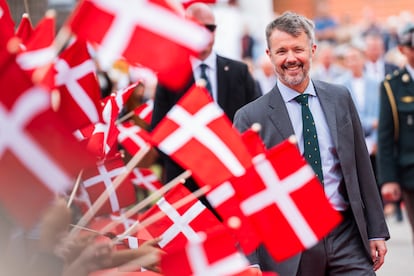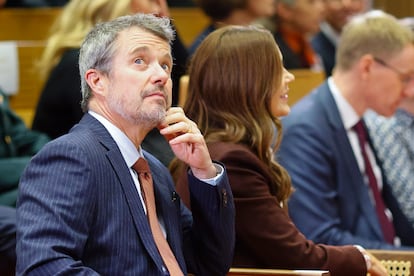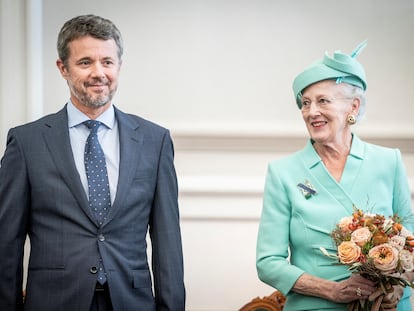Frederik X of Denmark wins over the Danes in his first year as king
After succeeding Queen Margrethe, King Frederik X faces the challenge of shaping his own legacy within a monarchy supported by 80% of the population. In recent months, he has emphasized priorities such as combating climate change and made a symbolic update to the royal coat of arms


The year 2024 was a good one for 56-year-old Frederik X of Denmark. A very good one. On January 14, he ascended to the throne after his mother, Queen Margrethe’s, surprise abdication, which was announced just two weeks earlier during her New Year’s speech. After five decades of reign and consistent popularity ratings nearing 80%, Margrethe left behind an impressive legacy. Frederik, however, has managed to match her approval ratings by the end of his first year as king. Together with his wife, Queen Mary, Frederik now faces the task of putting his own modern imprint on Denmark’s thousand-year-old monarchy, which continues to enjoy broad support from the Danish population.
Lars Hovbakke Sørensen, a historian and expert on the Danish monarchy, notes that while Queen Margrethe and King Frederik “are equally popular,” their styles differ significantly. “Margrethe, with her artistic and intellectual side, was a more formal figure. Frederik, by contrast, is more informal, which resonates with younger generations,” Sørensen tells EL PAÍS by phone.
Sørensen explains that support for the monarchy has always been broad, at “around 80%, with 15% identifying as republicans.” He attributes this approval largely to “the work of Queen Margrethe, who reigned without scandals or exaggerations.”
However, Frederik as a more informal sovereign faces the delicate task of balancing approachability with the dignity required to maintain the monarchy’s relevance. “There has to be a distinction between the sovereign and the citizens for the institution to make sense,” Sørensen says.
In 2024, Frederik and Mary of Denmark ushered in notable changes to the royal house alongside their extensive institutional duties. They prioritized greater transparency, particularly in disclosing the types of gifts received by the royal family, and have streamlined the number of patronages represented by the monarchs. The crown has also embraced modern issues, focusing on climate change, sustainability, human rights, and gender equality.
The royal couple actively engaged with the Danish people, traveling extensively and visiting Greenland — a testament to the autonomous territory’s importance to Denmark and the monarchy. Historian Lars Hovbakke Sørensen highlights Greenland’s significance to Frederik: “He spent a great deal of time there as a prince, immersed in its wild nature. And his children have Danish names, as well as typical Greenlander names.”
In his New Year’s address on December 31, Frederik X highlighted Greenland, an autonomous Danish territory located between the Atlantic and Arctic, and the Faroe Islands, an autonomous archipelago in the Atlantic. He also mentioned the Danish minority in South Schleswig, Germany, as a gesture to emphasize unity within the Kingdom of Denmark. In December, the monarch revised his coat of arms to give greater prominence to Greenland and the Faroe Islands: the Greenlandic polar bear and Faroe sheep now occupy a much larger space on the design.
Both territories share deep historical and cultural ties with Denmark, and their economies rely significantly on subsidies from Copenhagen. “Greenland is of interest today to China and the United States,” notes historian Hovbakke Sørensen, referring to the island’s strategic importance as it lies on the shortest route between North America and Europe.
While the Danish royal coat of arms has been updated three times since 1903, this latest modification could be interpreted as a subtle response to the U.S. president-elect, Donald Trump, who has repeatedly expressed interest in purchasing Greenland. However, Sørensen clarifies that “the king would not be making a political comment, but rather a symbolic one.”
Frederik of Denmark has displayed emotional vulnerability during moments of profound personal significance, endearing him further to the public. In 2004, he visibly wept with joy, handkerchief in hand, as he watched Mary Donaldson, his Australian fiancée and a graduate in Law and Commerce, walk down the central aisle of Copenhagen Cathedral to marry him. Frederik and Mary are now parents to four children: the heir, Christian, and Princes Isabella, Vincent, and Josephine.
Frederik showed similar emotion on the day of his proclamation as king. Stepping onto the balcony of Christiansborg Palace to greet a cheering public, he was visibly moved. Cameras captured him pausing, taking a deep breath before opening the window, and addressing the crowd with teary eyes. Reflecting on the moment in his New Year’s Eve speech, he said: “The crowd of people in front of me. My family right behind me. Stepping forward and meeting so much support, joy and love. Standing on the balcony together with Queen Mary as Denmark’s King and Queen. Taking it all in — or at least trying to — moved and overwhelmed. This is what I take with me. This is what we take with us. Forever. A thousand thanks.”
The Danish king has openly acknowledged the challenges he faced in coming to terms with his destiny during his youth. “He wanted to be a citizen like everyone else, and it took him a while to accept the role that awaited him,” explains historian Hovbakke Sørensen. The turning point came when Mary entered his life. “She helped him to recognize his destiny, as he himself has admitted,” Sørensen adds.
Even as Frederik embraces his new role, the shock of Queen Margrethe’s abdication continues to resonate across the country. “It is not a tradition in Denmark, as it is in the Netherlands. This was the first time in 500 years that a sovereign stepped down,” Sørensen notes. In the thousand-year history of the Danish monarchy, there are only “five or six examples of abdications.”

The outgoing queen, Margrethe, cited health issues as the reason for passing the baton to her eldest son. “There has also been talk that she did not want to wait too long and risk Frederik and Mary becoming older monarchs,” says Sørensen. Prince Christian, Frederik’s eldest son, turned 18 just two months before his grandmother’s abdication.“The timing was right,” says the expert, admitting it is “not officially confirmed” that this was the reason.
Sørensen also recalls rumors circulating in Denmark suggesting that Frederik’s ascension to the throne was accelerated by his alleged relationship with Spanish aristocrat Genoveva Casanova, the ex-wife of Cayetano Martínez de Irujo, son of the late Duchess of Alba. “It could have been a way to divert attention elsewhere, but we do not know what happened.”
In Denmark, the December 31 speech is a 150-year-old tradition, far from being a mere formality. “The king, and before him the queen, speaks about their view of society and how we relate to and treat each other as a people,” explains Sørensen. Although the text is reviewed and approved by the prime minister’s office — currently led by Social Democrat Mette Frederiksen — it is the monarch’s speech, not the government’s.
This year, Frederik X introduced something new by addressing global conflicts. “We are following the developments in the Middle East with bated breath [...] In Europe — not far from here — the Ukrainian people are fighting bravely for their freedom — and for ours,” he said. He also underscored the importance of NATO: “We can only solve global conflicts when we stand together internationally.”
The king also made a point of mentioning his brother, Prince Joachim, with whom he has reportedly had tensions following Queen Margrethe’s decision to streamline the royal family by removing prince and princess titles from Joachim’s children. Joachim, now based in the United States with his wife, Princess Marie, and two of their children, represents the Danish defense industry.
As he concluded his speech, Frederik echoed his mother’s tradition of ending with “God bless Denmark,” a hallmark of her 52-year reign.
Sign up for our weekly newsletter to get more English-language news coverage from EL PAÍS USA Edition
Tu suscripción se está usando en otro dispositivo
¿Quieres añadir otro usuario a tu suscripción?
Si continúas leyendo en este dispositivo, no se podrá leer en el otro.
FlechaTu suscripción se está usando en otro dispositivo y solo puedes acceder a EL PAÍS desde un dispositivo a la vez.
Si quieres compartir tu cuenta, cambia tu suscripción a la modalidad Premium, así podrás añadir otro usuario. Cada uno accederá con su propia cuenta de email, lo que os permitirá personalizar vuestra experiencia en EL PAÍS.
¿Tienes una suscripción de empresa? Accede aquí para contratar más cuentas.
En el caso de no saber quién está usando tu cuenta, te recomendamos cambiar tu contraseña aquí.
Si decides continuar compartiendo tu cuenta, este mensaje se mostrará en tu dispositivo y en el de la otra persona que está usando tu cuenta de forma indefinida, afectando a tu experiencia de lectura. Puedes consultar aquí los términos y condiciones de la suscripción digital.
More information
Archived In
Últimas noticias
ChatGPT fails the test: This is how it endangers the lives of minors
The late consecration of women artists in their 90s
The Florida Keys tourist paradise is besieged by immigration agents: ‘We’ve never seen anything like this’
The latest scam on WhatsApp behind the legal dream: using immigration status as bait
Most viewed
- Families demand repatriation of bodies of Colombians who died in Ukraine: ‘This war is a slaughterhouse for foreigners’
- The low-cost creative revolution: How technology is making art accessible to everyone
- Liset Menéndez de la Prida, neuroscientist: ‘It’s not normal to constantly seek pleasure; it’s important to be bored, to be calm’
- Christian Louboutin: ‘Young people don’t want to be like their parents. And if their parents wear sneakers, they’re going to look for something else’
- ‘El Limones’ and the growing union disguise of Mexican organized crime










































